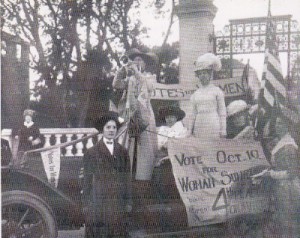 Here is a photo taken at the entrance to the U.C. Berkeley campus around 1910. All of the buildings and railings in the background are still there. The Suffragettes are gone. There is a widely held misconception about women’s suffrage. Most people assume that women could not vote prior to passage of the 19th Amendment, but that isn’t true. Prior to the ratification of the 19th Amendment in 1920, women’s suffrage was a state’s rights issue. That meant that the laws varied from state to state. In most Southern states, women could not vote at all. In many mid-western states, women had partial voting rights, which meant that they couldn’t vote in presidential elections, but they could vote on local matters, such as electing school boards, municipal judges, and town councils. In western states, women had full voting rights. In every state from the Rocky Mountains to the Pacific Ocean, women had full voting rights long before before the passage of the 19th Amendment. In some of the western territories, including Montana, Wyoming, and Washington; women had full voting rights before they obtained statehood. This was because the West was settled by frontier families. Women had more freedom and opportunities in the Old West than they had in the East. Women could do a lot of things in the west that only men were allowed to do back east, and that included the right to vote.
Here is a photo taken at the entrance to the U.C. Berkeley campus around 1910. All of the buildings and railings in the background are still there. The Suffragettes are gone. There is a widely held misconception about women’s suffrage. Most people assume that women could not vote prior to passage of the 19th Amendment, but that isn’t true. Prior to the ratification of the 19th Amendment in 1920, women’s suffrage was a state’s rights issue. That meant that the laws varied from state to state. In most Southern states, women could not vote at all. In many mid-western states, women had partial voting rights, which meant that they couldn’t vote in presidential elections, but they could vote on local matters, such as electing school boards, municipal judges, and town councils. In western states, women had full voting rights. In every state from the Rocky Mountains to the Pacific Ocean, women had full voting rights long before before the passage of the 19th Amendment. In some of the western territories, including Montana, Wyoming, and Washington; women had full voting rights before they obtained statehood. This was because the West was settled by frontier families. Women had more freedom and opportunities in the Old West than they had in the East. Women could do a lot of things in the west that only men were allowed to do back east, and that included the right to vote.
Mark Tarses Newsletter
